Welcome to the wonderful world of baking where flour, butter, and our collective sweet tooth’s (teeth? teeth’s??) come together to create an absolute mess in our kitchens. Dirty every dish, I say! In the name of cookies, of course. Whether you’re a seasoned baker, or just tying up the apron strings for the first time, knowing how to read a recipe is one of the most crucial steps in your baking success.
It’s easy to take for granted exactly how to read a recipe. There’s a lot of nuance in the structure of each recipe we encounter and I want you to know the ins and outs. A well-written recipe is invested in your success; you just have to know how to decode it.
Let’s roll it all the way back to basics. Let’s get on the same page, namely page 147 of Erin Jean McDowell’s Savory Baking.
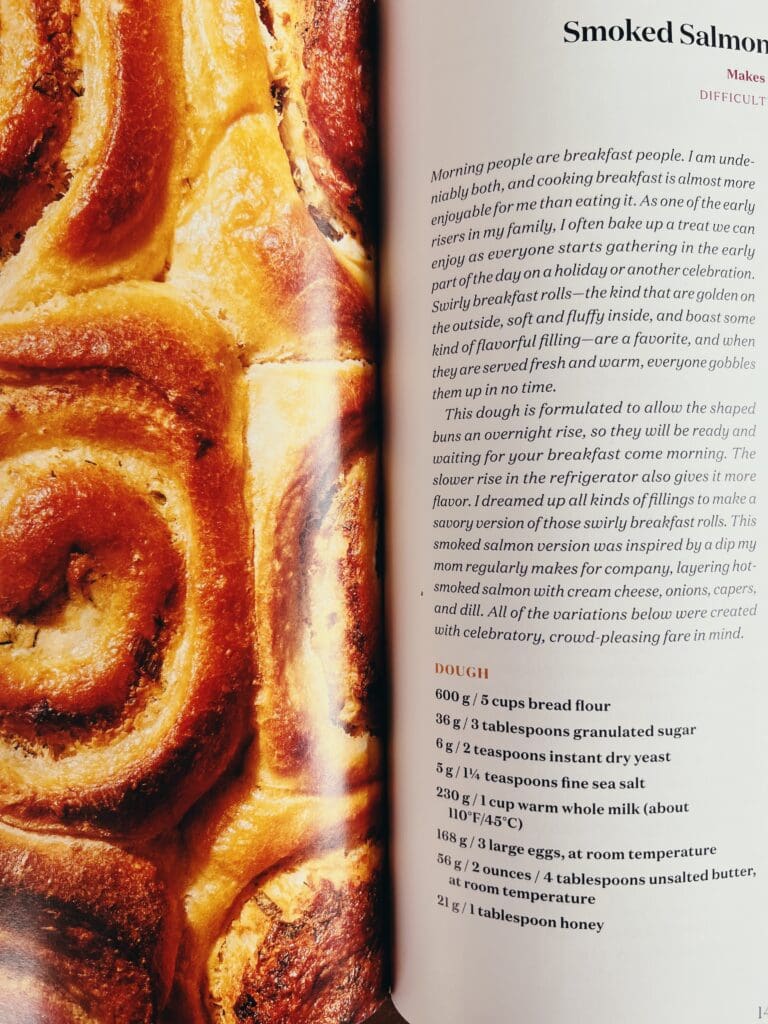
1. Read Through the Recipe
First of all, I understand this is like reading the instruction manual to the appliance you’re already pretty sure you know how to work. Who does that? Barely anyone. Just humor me and, before you start creaming butter and sugar, read through the entire recipe. Honestly, I’d settle for an intentioned scroll through the text. Believe me.
Reading a recipe from beginning to end is a big deal. The instructions may have some hidden ingredients (like water, for example), or split the ingredients within the list in an expected way (like using one egg for batter and one for an egg wash). You want to know the lay of the land before you start throwing things in a bowl. Read the dang recipe thaaaaanks!
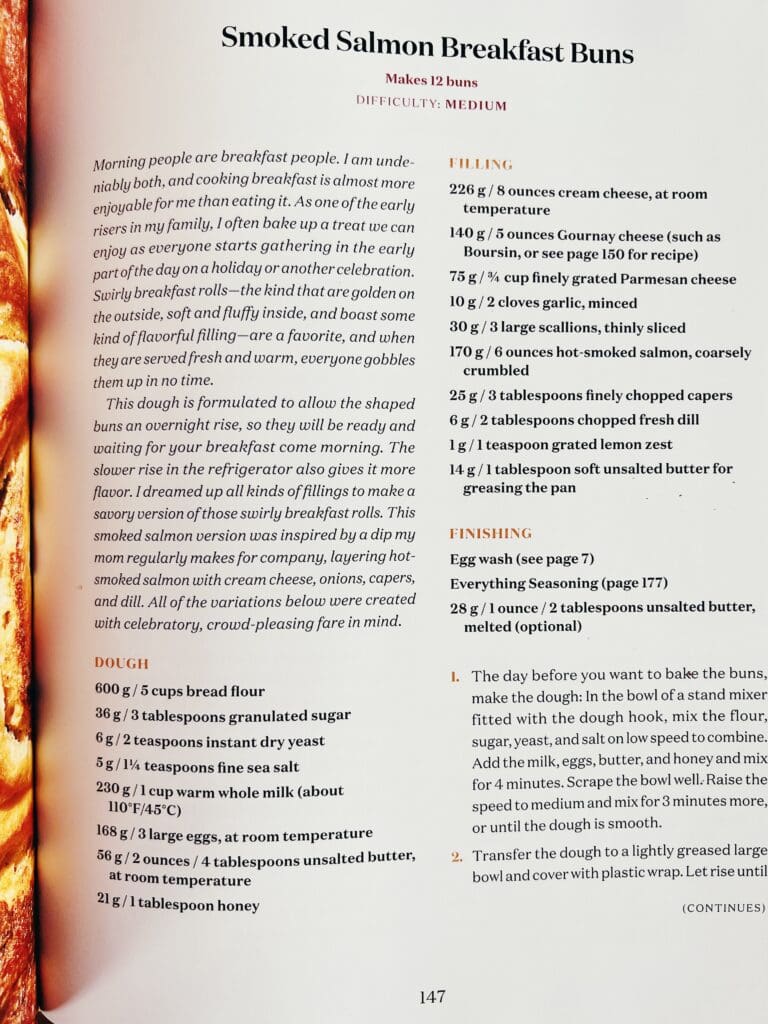
2. Understand the Ingredient List
A recipe’s ingredient list is detailed in the order the ingredient will be used! Not only is the recipe list a very helpful shopping list, but it also gives you insight into how the recipe will come together.
In Erin’s recipe above, for example, we know that bread flour is the first ingredient, followed by sugar, yeast, and salt. Without even looking at the instructions, we can gather that we’ll whisk sugar, yeast and salt into the flour in that order. But hey, we’re not assuming anything. Refer to step 1. We’re reading the recipe.
3. Mind the Comma
You’ll notice that many ingredients in the recipe list are followed by a comma and a direction. Pay attention to what happens after that comma.
After the comma you’ll generally find an instruction in regards to an ingredient’s temperature (like melted or at room temperature) or an action (like chop, mince, or dice) that needs to befall the ingredient. Every cut, chop, dice, and melting instruction after a comma in an ingredient list is to be done after the ingredient is measured.
For example: 2 garlic cloves, minced and 6-ounces hot-smoked salmon, coarsely crumbled
The absence of a comma is also revealing. For example: 3/4 tablespoon finely grated parmesan cheese and 3 tablespoons finely chopped capers
The absence of a comma mean the action (like grating or chopping) takes place before the ingredient is measured.
4. Pack, Soften, and Preheat: The Devil in the Details
Recipe lists often request that brown sugar be “packed”. Take the back of a spoon and firmly (but not totally Hulk-style) press the sugar into the measuring cup. Add more sugar and pack until sugar is flush with the top of the measuring cup. If the recipe indicates grams versus volume measurements – you’ll have a precisely measurement of a packed cup of brown sugar.
Soften butter by allowing it to rest at room temperature for about 1 hour. Don’t cheat yourself or the butter by not allowing the butter to soften before combining it with sugar and eggs. The temperature of ingredients is key when it comes to baking.
Preheat the oven. Yeasted dough hates a 200 degree F oven but sure does love a 325 degree F oven. Again, temperature is a big deal!
5. Is It Done Yet!?
Doneness is recipe instructions are usually described by a time range and visual cues.
For example: Bake 55 to 65 minutes, until rolls are lightly browned; they should have an internal temp of 190 degrees F.
I typically set my timer for 5 minutes below the lowest indicated time. Just in case – you can’t take back an overbake. Use time, looks, and temperature to decide if your baked goods are done. With practice, you’ll be able to smell exactly when a recipe is done. It’s wild!
More in the Baking 101 Series:
My Top 5 Fall Baking Tips because we could all stand to freshen up our baking powder.
My Top 15 Kitchen Splurges That Makes My Time in the Kitchen So Much Better from linen aprons to bench scrapers and a very nice wooden rotating tray.
How To Test Your Oven With Toast so, grab some butter because we’re about to have toast for lunch.

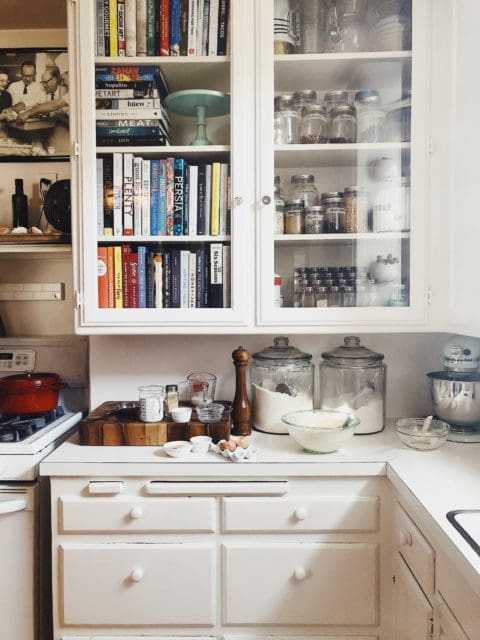

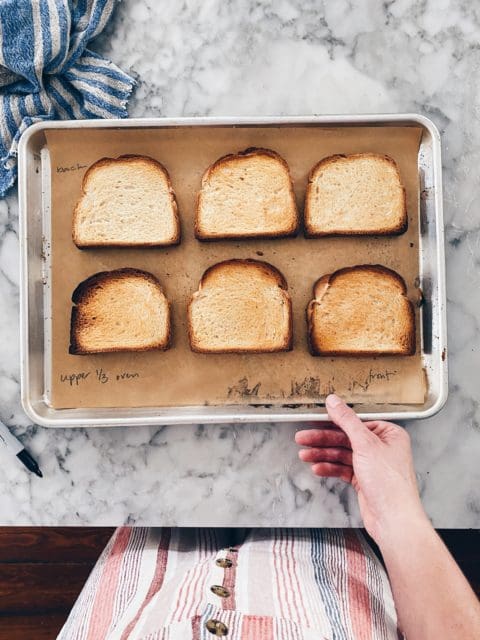
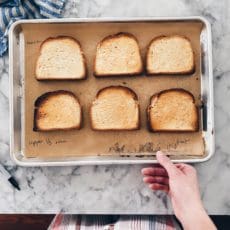

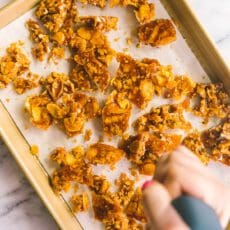


Vicki Bauerle
Great information! especially the coma info.
Margot
This is such a timely and much needed post. I find with blogging being so popular there are a lot of bloggers out there who are talented (and often merely capable – almost) of baking, sewing, etc. but are not capable of writing a recipe or pattern in the correct way.
Debra
This was a needed article- we rush in and think we got this and after a reread to find out we missed this or that. Even us old cooks who know better will find ourselves not taking time to read and understand the recipe sometimes. I make myself slow down and find a comfortable chair and quietly read through the recipe. Then go through the cabinet and pull out the ingredients- so often I’m sure I’ve got that and I don’t.
Joy the Baker
I hear you, Debra! I find myself needing to take my own advise more often than I care to admit. :)
Michelle Harvey
This was awesome, Joy! (And, funny!) My takeaway is to #RespectTheComma. Thanks for sharing!
Nelson mandela
Yess hahaa
Linda Hunter
This was the most informative and fun website I have ever visited. It me gave so much needed information in a fun way. I just kept on reading and learning things about recipes that I never knew before. I will tell all friends so they can visit and learn as I did.
Alan
How to write a recipe …
It drives me crazy when amounts for some things are in volume measure, and for some they’re in unspecified “ounces”. It would be much better to state “weight ounces” as the counterpart to “fluid ounces”, and never leave it unspecified.
Carol Ponzo
How about the timing of baking cookies when the recipe doesn’t specify the type of baking sheet? I like to bake on parchment paper to get a clean cookie off the sheet rather than one where the bottom is a little messed up from the spatula. When I bake on shiny sheets with parchment paper it takes longer to bake as compared with a darker tray without parchment paper. Also, when should you bake in a convection oven and how does that affect the end product and how does that affect the baking time? I appreciate your knowledge and advice.
joythebaker
These are all good questions, I will write a blog post on it.
Aline
You’re so funny! Love reading your posts!
Thanks JOY!
Kate
Will adding an extra egg to a pound cake recipe make it lighter or denser?
joythebaker
I think it would make it more dense. That’s what I think!
Adalee
It will make it denser.
Leona
Thanks for the great post! May I print and distribute to my high school “healthy foods” class?
joythebaker
sure!
Barbara Natale
why receipts do not give temps for when it is done 190 for bread etc.
samantha
2 C sifted flour = you sift before measuring
2 C flour, sifted = you sift after measuring correct
joythebaker
Yes, that is correct!
Fikrat
You are a great hard worker, helping and giving good information’s for all .
Iga Berry
Thank you! Some things are obvious yet they needed to be said. Do you keep your inspirations in one place? To read more go to https://www.igaberry.com/ Have a lovely day, Iga x
absurdlypeculiar
These are really great tips! I didn’t know ingredients are usually listed in a certain order.
http://www.absurdlypeculiar.blogspot.com
mutya lazatin
This is really an eye opener for me. From now on i will pay more attention on the commas :-)
Juliejulie
Thank you for this post. I never knew how to read a recipe before, and I’ve been doing it wrong for years. Also, your post about flour sifting was also brand new to me, and thank you for that as well.
Tania
This. Is. Brilliance. Had no idea about the comma!!
sandra
another insightful post. Thanks!
Michelle Sexton
what??? I totally didn’t even know about the comma thing! Super helpful. :)
Brandon @ Kitchen Konfidence
This is great. One of the most important lessons for the home cook EVER. A lesson I’m still trying to teach to my boyfriend. He loves to cook, but always seems to miss the steps that say “chill in the refrigerator for 4 hours” or “marinate overnight” :P
K
I know I’m a but behind, but if you haven’t done so already, I’d love a few tips on high-altitude baking! Especially an easy, practical explanation of why to do something different. For ex. I live in a high & dry climate and always thought the danger would be not enough moisture in a mix, but store-bought mixes (gasp!) always tell you to add extra flour…? Why? Anyway, I’d love to hear your take on high-altitude baking!
capturing joy with kristen duke
love this. made me laugh, too:)
Emily @ Life on Food
So true. This post made me laugh. I know these things. I swear. I still cheat. Bad me.
Lisa
You’ve blown my mind with “respect the comma”. I may actually try baking again since now I know at least one thing I was always doing wrong.
Jenny
Please, please, please, Joy. Will you go over frosting/icing/buttercream recipes? I’m a fly by the seat of my pants baker (the worst kind) who always manages to pull it off…except when it comes to the sweet delicious topping for my cakes and cupcakes. A vital component, says my inner child. Any tips/tricks on whipping a non-melty, non-grainy buttercream (the kind that sits proudly atop the cake like a crown, rather than one that dribbles down and slops off the cupcake….the kind I can *gasp* even put into a pastry bag and pipe when I’m feeling daring)….I would so appreciate!
Kelly
You learn something new everyday! I wasn’t aware of the “rule” behind the [comma]. Good to know!
Daniella
I’m always confused by flour. I have AP in the panty, and I use it for everything. It is really necessary to have cake flour, almond…yadda, yadda?
Whitney Ortega
I definitely needed to read this “Read the dang recipe.” I just wrote a blog post on how I’m a terrible recipe follower. I always jump in after reading the first line only.
michelle
hey joy, this is really really useful. I must respect the comma! many times, i take it the other way and now i know where i went wrong… thank you!!!
Natalia
I have another question, this time is not about reading a recipe, but it’s about making frosting.
I find that if I put butter in my frosting it tastes very sour??…. I think it’s something to do with the butter in Europe which tastes a little bit different from the butter in the U.S… is there a butter”less” option I could use???
Thanks!!!!!
Mira C
Thank you so much for starting this series! These tips are so helpful (especially about the commas! I had no idea!).
Kate
Does anyone ever have the problem where, whatever you are baking finishes (or looks/feels done) a far bit earlier then the suggested time? For example I made cupcakes that were supposed to take 25-30 minutes and they finished at 17 minutes? I can never tell if that’s an oven problem or maybe I’m mixing the batter for too long or incorrectly? Thanks! Love your work Joy, you pretty much changed the way I look at food, including my new fav pb & pickle! – Kate
Renee @ Awesome on $20
I always hear bakers talk about how important it is to measure your ingredients by weight rather than volume, yet so few baking recipes actually include measurements in grams or ounces. I find weighing ingredients to be much easier, but I hate math. I’m not about to do all those conversions before I start my cupcakes. That’s why I love British cookbooks. Metric, baby. Let’s get on the train.
Abra
I am excited about the things I will learn from this series!
I would like to learn more about brown sugars. If the recipe doesn’t specifically state it should be light or dark, is it safe to assume I can use whatever kind I want (or have on hand)? What do I need to be aware of in regards to this?
Clara
Can you please post the rest of that brownie recipe?!
Winnie
Even though I’ve been cooking/baking for over half of my lifetime, I still managed to glean some tricks from this! (especially the comma thing)
Thanks so much! :)
Autumn
I love this so much!! I read the recipes very carefully but I get confused when it comes to the “commas” in the ingredients. Thank you for helping me clarify this. My mom is an English teacher and we just had a conversation about the placement of commas. She totally agrees with you, too.
I was wondering if you could a post about buying quality chocolate for recipes. I am new to the “add your own chocolate” to recipes game and I do not want to skimp on it.
GuRLiee
I’m a decent baker but recently I have been seeing for example: 1 cup Liquid milk, or 1 cup milk, not liquid how can something that is liquid not be liquid, I’m seeing this more and more and am very confused. Thank You!
cora
how do you write a recipe?
like, really? how do you make a recipe your own? where is the line between adapting a recipe and being it’s author/mamma.
Amanda
I am so proud to say that I actually passed this test with flying colors (welling up with pride). But I am 46, so I’ve had plenty of years to make mistakes LOL I’m guilty of not softening my butter like I should. I just slice it super thin into the mixer bowl and that usually works pretty well. Not the right way, but it works haha GREAT post! (The comma trick seems to be the one that trips up most people!)
Lee Faber
Joy, this is a very good article. And you make some very good points. But not all recipes are well-written. I’m a cookery book editor and you would be surprised how many sloppily written recipes there are out there. There is nothing more frustrating to a cook than following a recipe to the letter and having the recipe turn out wrong because of carelessness (ingredients forgotten), wrong measurements, wrong temperatures for cooking or baking., etc.
Bere
Awesome post! Thanks for the pointers!
Most of my baking is very spontaneous, which means that i do not really have time to let butter soften at room temperature. Is it ok to soften it in the microwave without melting it completely?
Looking forward to your next posts!
Lindsay
I’m curious about cookie sheets/bake pans!
I’ve ruined batches of cookies not knowing what to do with a regular cookie sheet vs. insulated cookie sheet and the use of Silpat
Tracy | Peanut Butter and Onion
SO many great points in this ,,, thanks for sharing and I’ll look out for more tips.
fardus
Joy, you inspire me soooo much! Absolutely love your pictures and your blog. Brilliant indeed! Loads of love from Swedeeeen!
SK Brandy
I live in Sarasota Florida where it can be quite humid. How would you recommend storing crisp chocolate chip cookies to keep them crisp and how quickly would you store them once the cookies cooled but the chocolate chips are still on soft side?
Jenny
Awesome series idea!
How about discussing yeast and how to best work with it and some tips for finding a warm place for doughs to rise. (we have a cool and drafty home).
Thanks as always Joy!
shelly @ ohshellsbells
not reading the entire recipe first had burned me SO MANY TIMES. And I never learn from my mistakes, thanks to my awful memory. Maybe reading it here will save me from myself!!
Sasha | Global Table Adventure
Oh, Joy… only you could make a how-to about Recipe Reading entertaining. That’s a gift, right there.
Natalia
What about when you are in a hurry and your eggs, butter and milk (yogurt, buttermilk) are cold… how do I bring them to room temperature??? and why is it important that they are at room temperature???
Christina @ Scaredy Cat Kitchen
I’d never really thought about the comma thing before, but you’re right, it’s super important! You can’t be too precise with baking.
Debbie Q
I have been baking since I was knee high to a grasshopper….and I never knew that the comma after ingredients meant anything other than the person writing out the recipe was a stickler for grammar!!
Michelle
Oh my gosh – seems totes obvs now, but I never realised the comma was so important!
Miss Kim @ behgopa
Wow..kudos! You are a great teacher….far better than some of the stupid instructors I’ve had at culinary school.
Susan
Funny that you should post this. Over Labor Day weekend, my daughters and I had this exact conversation. My one daughter took out one of my cookbooks and we went through different recipes and talked about the ingredients and the whole process of several recipes. Both of them were amazed and never realized all the different nuances a recipe can have. Great post. I will forward it on to each of them!
Caitlin Hicks
wowza,
that comma stuff has opened a whole new world for me. interesting.
Alisha
This is my exact process!!!! YAY for solidarity!
kay
Great tips! I never knew the commas were so important! Hope to learn more from you in the subsequent posts! I have a question about measuring flour which I hope you’ll touch on – when measuring flour in volume, should flour be measured when it is packed/loose, and how packed/loose should it be? I always have the problem of measuring say 2 cups of flour but after shaking the measuring cup a bit, the 2 cups of flour becomes 1 1/2 cups or so! How now?
Looking forward to your posts!
Leah
I’m already loving this new series! thank you!!
Marilyn
Love this post! Can’t wait for the upcoming ones :)
Kim
Cookie doneness and stop the spreading. I either end up with flat crispy cookies or have to bake forever and nearly burn the bottom but middle is raw.
Kelsey
I’d love to know your recommendations for baking pans, types and materials. I am suspicious that my bread pan is at fault for my banana bread that is dry and brown on the ends but gooey in the middle.
Heidi - Apples Under My Bed
Oh it’s SO in the comma! Thank you for this reminder. This series will be most helpful. I’d love to learn more on the differences between cream. Recipes often call for heavy cream but in Australia we have different cream so is it all generally to do with the milk fat content? What about thickened cream with all those thickeners added – whatever happened to just straight cream, you know? How do we choose the right cream for certain recipes? If you can’t address this question than that’s fine, it may be an Aus specific cream f-up. Thanks, Joy!
Heidi xo
Catherine
Thank you for this, so great! My biggest challenge is when I like a few recipes and want to combine them… I feel like this is such a no-no when baking (always follow the recipe). What is the best way to insert new ingredients and nix others, etc?
kaylee
pie crusts scare me. please send help.
Annie @ Natural Sweet Recipes
Looovve this! As a food blogger, this is really helpful to remember how to explain things accurately and consistently. Everyone needs to know how to read a recipe in order for success! So glad you thought to get everyone on the same page in time for the holidays!! :)
Amy
“Ya Heard” !!!? Why don’t you stop fooling yo’self and move down here to New Orleans already!?
Melissa Lewis
This series is brilliant. I just thought I knew how to read a recipe! Love it!
~Melissa
Erika
Love this post!
Looking forward to your upcoming posts about baking! Tis the season, for sure :)
Marti
Whether you are an experience baker or not, it’s good to review procedures before we invest heavily in our classy ingredients. One piece of advice I got from David Lebovitz’s wonderful blog is related to this: lay out the ingredients and measure everything BEFORE you mix them, rather than rush right in. Not that I always do this: I have been known to leave the yeast out of bread…but it’s a good policy, right?
Katheryn
I love that you’re doing this! Super helpful.
Sarah @ Miss Candiquik
LOVE this. Can’t tell you how many times (in my younger days ;)) that I’ve failed to read the recipe from start to finish and had no idea what I was getting myself into.
Lol.
Thanks for this post, a good read!
Sarah @ Miss Candiquik
LOVE this. Can’t tell you how many times (in my younger days ;)) that I’ve failed to read the recipe from start to finish and had no idea what I was getting myself into.
Lol.
Thanks for this post, a good read!
Sandra
I’m so confused! I thought we were always supposed to pre-sift flour? I swear I heard that on a JTB podcast. I could be wrong though. When is it appropriate to sift flour and when is it not?
gingermae
the comma! I had no idea. thank you for that, and for future revelations I am sure to find out from you.
Amanda @ Once Upon a Recipe
i think i’m going to love this series! you so smart.
Cathy/ShowFoodChef
This is a superb idea and I can’t think of a better more engaging person to present it! Brava!
Amy P
Great post! I’ve had to learn all these things the hard way…particularly what ‘creaming’ butter and sugar looks like. 30 seconds does not do it, friends. Lots of sub-par baking around here until I learned to a) use a scale and b) google things like what creamed butter & sugar look like.
Quyen
One of my annoyances about baking recipes is that 1 cup of flour for everyone is different, so you have to using some logic in adding more flour or liquid if it doesn’t turn out the way you expect. That is why I like bread recipes because they give you the weight of the flour.
https://liveitinerantly.com
Jamie
Thank you for sharing your infinite wisdom with us lowly amateurs! I never know that about the commas, life changing!
cassie
If I forget to let the butter soften at room temperature, can I microwave it? Also, how badly do I need a pastry cutter? Can I go without?
megan b.
i’m totally overwhelmed by the many types of baking flour. could you translate? is it really critical to use exactly the type of flour called for?
Liz D.
So helpful, thank you! I never paid that much attention to the comma, will do so in the future.
Amanda D
I love the idea of baking basics. Everyone can learn something, just like I learned about the difference a comma can make. yay grammar!
as far as baking suggestions/questions go, could you talk about whipping egg whites for certain recipes: how long does it take, tips for success, soft vs stiff peaks??
thanks.
Michelle @ Permanent Daydream
This is really helpful! I learned a lot. Thanks for posting this. Sometimes I get intimidated when recipes tell me to divide and sift and all those things so I skip them because I wasn’t sure what to do. Now I will give it a shot… :)
Tina
Wow! This was incredibly helpful. Thanks, Joy!
dixya| food, pleasure, and health
this is a MUST read by anyone who likes to cook or read. I am so looking forward to learn more. Thanks :)
Stephane
Great advice! Visit my blog! https://thebrunettekitchenette.blogspot.be/
Belen
Love this. Super helpful, especially the,,,,,,,,!
Dana @ Conscious Kitchen Blog
I love this guide, Joy! I can’t wait for more, especially the “how-to” on creaming butter and sugar. Pretty sure I don’t do that right…
Annie
AHHH!!! I couldn’t be MORE excited for this series! I’m like an intermediate beginner. Here are some ideas for stuff I would read the crap out of :)
• Handling melted chocolate so my cookies don’t look like they were dipped/drizzled like a 4 year-old.
• How to make perfect melty cookies… mine ALWAYS seem dryer, but seem perfectly “done.” Like I want the chocolate inside to be melt in your mouth awesome!
• Basic baking supplies; what pans do I reallllly need?
• I’d really love to know more about the “ratios in baking.” Like… I want to make monster cookies with specific ingredients, but I am SUPER scared of altering a recipe especially to want to add something like oatmeal!
Krys
OMG, I’ve been baking since I was 11 and I didn’t know the comma rule! Thanks for this!!!
Katie
Well this is truly splendid. I’m excited for this series (can one call it a series? I’m totally calling it a series).
Respect the comma…great, great advice.
Lisa
Will you continue talking about this brownie recipe as your example in upcoming posts? I ask because I’d like to try them and did not see what size pan they cook in and at what temperature. Thank you for this post. I love your blog.
Audrey
Ok, so I’m a newbie around here and am so appreciative that you’re doing this series. I love to cook. I can cook like it’s my job, but when it comes to baking…it’s embarrassing the amount of skill that I do not have. Just last week I could not get the creamed butter and sugar to a smooth texture. WTH? I must be making this way more difficult than it needs to be. Looking forward to learning…
Lisa Klow
How do you adjust for humidity? I’ve heard professional bakers mention this, but never how, like it’s a trade secret.
Sasha
omg joy! i broke my oven yesterday and now it’s baking season and i can’t bake! :'( just had to share with someone who understands.
your guide is very helpful. I had to figure this things out by myself and it’s very nice to have it explained once again :)
ps. i’ve discovered your blog this summer and fell in love! i’ve read it all, every post, and i must tell you: YOU ROCK! thanks for being so awesome!
Arthur in the Garden!
Great reminder!
Kristin
I laughed out loud when you said to read the whole recipe. I am so bad about that – I hate reading through beforehand and I tend to skim, which drives my husband nuts. There is nothing worse than being in the middle of cooking dinner and suddenly reading the words “marinate four hours.”
Kate
Thank you!! I always wondered about when to chop and measure things so that clears that right up. I’m really excited about this little series!
Abby @ The Frosted Vegan
This is great! I love the tip with the comma, it is so true and can make all the difference.
J.S. @ Sun Diego Eats
Used to be so bad at reading recipes, its the worst feeling to have a batter made and then to realize you need ingredient X which you definitely do not have in your home!
LAURA
Hi Joy!
First off, I am a HUGE fan! Thanks for being awesome. I am soooo not a baker, but I do like baking (if that makes sense.) I was wondering if you could do a sort of list of things that beginning bakers should really have in their kitchen. Sort of like a starter kit. I think that would be a big help to get beginning bakers started. Thanks!
joythebaker
totally!
Amanda
As I am in the throws of editing my recipes for the book, I am appreciating this most so much! Excellent tips and insights!
Amy Kelly
Loved the part about the importance of the comma in a recipe. I never really thought that deeply about it before, but it’s totally helpful when I’ve been a little confused in the past about measurements (particularly with veggies when cooking).
Heather @ French Press
only you can make the basic aspect of reading a recipe entertaining! LOVE this post
Beth @ bethcakes
Wonderful post! Even after baking for a few years, I still learned a lot from this. Didn’t know about the comma thing AT ALL. Looking forward to more of these posts. :)
MaryEllen
I was wondering what affect adding chocolate in its different forms has on leavening. For example, if I were to add chocolate to your brown butter doughnut recipe, what adjustments would I need to make to the baking soda and powder and then what adjustments to acidity? Is there a formula for that? And how does it differ from cocoa powder to melted chocolate and what about they type of chocolate?
I always need more tools for successfully adding chocolate to recipes, lol.
Thanks!
KMont
This is a genius idea for a blog series. And I learned something! Pretty much figured the ingredient list was in order of usage, but it’s so nice to have that confirmed. And your Respect the Comma advice is just what I needed. I’ve questioned that exact detail so many times!
Lauren
I can already tell I’m going to love this series! Thank you!
I love all the great new recipes and beautiful styling that I see in “blogland” but some bloggers don’t know that the ingredients list usually goes in the order of use and it makes it so hard when I’m making a recipe from them.
I would love to see “To sift or not to sift”
And also adding wet ingredients to dry or dry ingredients to wet. I usually just follow what the recipe is, but I have no idea what the difference is or if there is one. Thank you!!!
Maureen
I’m an experienced baker and cook, yet as always, I have been entertained while reading this useful information. Shared the link on my FB page, since I have many FB friends who are intimidated by the whole idea of baking, especially of the recipe and methods. Thanks!
Kathleen
I am SUPER EXCITED about this!!!! :)
Marie
I’ve actually never thought about the comma thing, that’s genious!
Erica
Love this little series! And I love that you started with “read the dang recipe.” TOO often I have finished mixing something up that just doesn’t look right, and THEN I look at the recipe and realize that I’ve, for example, added the butter that was supposed to be set aside for the crumb topping into the actual cake batter itself. Should have read the dang recipe! :)
Question: When a recipe says to add the dry ingredients to the wet ingredients in several small additions (not all at once), WHY is that necessary? I often get impatient and just add it all at once, and things seem to turn out okay. But am I missing something important?
Thanks! :)
joythebaker
we can totally discuss!
Jess
Can you talk about using unsalted butter vs. salted butter? I never know which one to buy and when to appropriately use either
joythebaker
definitely!!
tawnya35
I love this! I am an avid baker and I run into people all the time who say that they can not bake and I am like YES, you can! It’s so easy! They have it in their head because they can not just toss stuff together like when you cook, they can not bake! I think I will send them here the next time someone tells me that!! This was a nice refresher for me.
Kris
Maybe I’m not getting something, but how is 4 ounces of chocolate, chopped different from 4 ounces of chopped chocolate? It’s going to weigh the same before and after chopping. I completely understand how the comma makes a ton of sense for things like flour, nuts, etc., but here I don’t get it.
JC Carter
I love this. I have been baking since I could walk, but never paid much head to commas. It makes me wonder what else I have been missing this whole time, I can’t wait to see what else you have in mind for this series, I think it’s a wonderful idea!
Ruth C
I learned something today! Thanks Joy :)
Now I know about “the comma.”
Todd @ HonestlyYUM
I owe you for this one Joy. You have no idea…
Amanda
This was a great post, reading a recipe *in it’s entirety* is incredibly important. I suspect that many people, including myself, have learned this the hard way! Thanks for sharing, I’m looking forward to the next post in this series!
Cortney
Great article to start the day! Now all I’m going to be thinking about at work is brownies…thanks. ;) My pick for a baking 101 would be on higher altitude cooking. Cookies are pretty easy to judge how much flour I need to add, but cakes are my biggest problem. They always tend to sink in the middle, and I promise you, I take all the steps listed in the recipe, respecting the commas & everything. I’m about 5,500 ft. Any advice would be greatly appreciated!
Diane
Thanks! A great post.
Kaylie @ Skinny Muffin
Totally genius. I’ve been baking for years and didn’t know some of these things. Thanks!
Samantha
These are such helpful tips!
Garden, Home and Party
Joy,
I so appreciate this. I love to cook and bake but am a novice and still find certain recipes challenging. This is great and, as always, entertaining…love your wit.
Karen
T
I never realized the difference a comma makes?! I will reread my recioes again for sure. Great article! I look forward to the rest of the 101s.
Hannah
I have always wanted to know why recipes that call for eggs always say “large” egg. I’ve never seen a “small” or “medium” egg at the grocery store. So what’s with the specification??
joythebaker
good one! we should totally talk about this!
Gem
In the UK we have small, medium and large eggs – maybe it’s crept over to you from us?
Helen
You did not mention baking pan size and or prep… greased/ungreased. HELP. Dying to make these brownies.
Kendra
Question. When is it okay to use the milk-vinegar situation instead of buttermilk? Are there are certain kinds of recipes where the real thing is important? The same can be true of any substitutions – when are substitutions okay?
Great series. P.S. Your book is MY favorite baking cookbook.
joythebaker
we can talk about buttermilk for sure!
DessertForTwo
Thank you, THANK YOU for writing this. I respect the comma! Others do not! I feel like I should have this as a pop-up on my blog before someone clicks ‘print recipe.’ Like, “do you know how to read a recipe? Click here to have Joy explains it to you.” Take a short 20-question test, if you pass, then you get to print my recipe :)
That’s a little extreme, but…you know, bakers: we’re easily frustrated.
xo
Cecelia
1. When I check a recipe for “done-ness” and realize it needs more time – how much heat escapes the oven? And how much does that affect how long I still need to leave it in for?
2. And how long are you supposed to alter cooking time if you put in, say, 2 trays of brownies instead of 1?
joythebaker
oh good questions! as long as you don’t keep the oven open for more than 2 minutes or so, you should be fine to put the brownies back in and have them finish baking successfully. the amount of trays in your oven depends entirely on the size of your oven. i have a small oven and two trays can be unsuccessful unless i rotate the baked goods two or three times during baking.
Grace
Great advice! I definitely like doing recipes in the order things are listed. My husband thinks I’m OCD, but now I can point to this post and prove him wrong! ;)
https://sometimesgracefully.com
Bill Clifford
My wife sent me a link to this site. She knows how much I need your help. While I have sort of figured out most of what you said about reading a recipe I really appreciated the overview – and I know there more to learn about reading recipes. Recipes are full of technical terms that seem to be obvious to the writer of recipes, but are not obvious to me. I am sorry that I forgotten a lot of my god examples, but creaming butter is surely one of them.
One time I was trying to bake something and the recipe called for doing something to the “dry” ingredients. So I did what was called for with all the non-wet ingredients. The result was not what the recipe intended. My wife asked me what I had done, and I explained it to her. She was incredulous. I had mixed dry and non-dry ingredients. Apparently “dry” ingredients does not mean all non-wet ingredients, but only those non-wet ingredients on some unknown list. I still don’t know what ingredients are considered “dry.” So I am looking forward to my enlightenment.
Bruce Andrews
Probably the best idea is to find a recipe that measures anything above a tablespoon in weight, or use an online converter to figure out the exact amount; four people can measure three cups of flour and come up with significantly different weights, whereas the people measuring by weight will generally arrive at the same number of cups (volume).
Figure out which country the recipe is from then use something like https://www.onlineconversion.com/weight_volume_cooking.htm to transform the measurements into the proper weights; as a bonus it makes it way easier to scale the recipe by arbitrary amounts; if you wanted to increase a 8″ cake to a 9″ one, for example, it’s easier to multiply weights than cups, and it’s easier to precisely measure 190 grams (6.7oz) of milk than 185ml (6.3 fl oz) – which, when scaling a recipe, you might require.
You can even divide eggs properly when doing it by weight, but only if you think the recipe might go wrong if you have slightly too much (like macarons). Figure out the weight of a “large” egg in that country’s definition (they vary quite widely), crack enough eggs to exceed the desired weight, beat them together with a fork to break them up, then measure the amount required (and do something else with the rest).
It probably sounds like a bit of effort, but it’s essential for someone – like me – who is following American recipes without owning any American cups; whenever I find a recipe I have to translate it to weights in order to measure it properly (Australian cups, tablespoons, and egg sizes are different, which kind of matters in something like macarons, so weight is more reliable).
So yeah, recipes with weights are fantastic. Pick those ones, if possible. Besides, that way you can measure the walnuts before cutting them.
Gem
This is very useful. :) I know you guys in the USA don’t use scales in the kitchen much, but that might be worth touching on in a future Baking 101 post.
joythebaker
for sure!
Neev
I have always read the whole recipe fr start to end before baking, infant I plan and I imagine the whole process in my mind too. But yes not everyone does it and yr baking 101 will help them.
I sometimes cheat with my butter by placing it in the microwave to soften (stay close or you will have runny butter).
Will follow yr new chapter.
laura
Question: When i forget to leave the butter out to soften I put it in the microwave a few seconds. Sometimes it goes from “soften” to “melted.”
How does this affect the recipe?
joythebaker
don’t use the dang microwave! we’ll talk about softening butter soon!
timberdawn
Oh, thank you! I bake lots and lots of cookies at holiday time and am wondering how many of them should have been “better”. At any rate, I always struggle a bit with:
When is it done? How is this cookie sheet different from that one? Are the parchment paper lined ones baking at a different rate than the silipat? How early can I begin – i.e. which recipes freeze best and what is the best packaging to keep them freshest? I call the nursing home and get numbers of how many workers on each shift for holiday work and then prep 3 separate trays so each shift has a go at all the types of goodies that I have prepared. Hate to think of the favorites all disappearing and the last workers getting the dregs, albeit yummy dregs. Thanks again!
jeananne
I love reading recipes! it helps me savor & relish what I am baking even before the final result. Thanks Joy, this will be a great series!
Michaela
These are the basics but it took me several months to really understand how important this all is. Thanks Joy! You have great ideas and great personality and I just love your blog.
My question is: is there any difference between adding wet ingredients to dry ingredients and dry ingredients to wet ingredients?
Javi Trulove
I”m Trully going to love this “Baking 101” posts, i’m an amateur baker who learn like every day something new and i have a feeling that this is going to make me improove a bit better my baker skills.
Sini
I think this is a really great series, Joy! I’m soooo ready for the turn-your-oven-on-and-bake-things season. Let’s get baking (and eating everything chocolate)!
Michelle @ A Healthy Mrs
The turn-your-oven-on-and-bake-things season is my favorite! And it does soften things a bit for those who aren’t quite ready for fall :)
Kristina
Love this- such a great idea and can’t wait to get more ” baking breakdowns”!
Meredith
Oh. My. Word. I’ve been baking for years and have always measured before chopping. *head palm*. You CAN teach an ol dog new tricks!
Regina
But…but…okay, I get that “1 cup chopped walnuts” can measure very differently than “1 cup walnuts, chopped,” but isn’t 4 ounces of chocolate always 4 ounces of chocolate? The weight isn’t going to change just because you chopped it…is it? Granted, it’s much easier to just plop the little squares out of the package all pre-weighed, but…I feel like I’m failing a math lesson. Or maybe physics. Or Brownies 101.
Elizabeth
I was going to point out this same thing. 4 ounces (and any weight for that matter) is 4 ounces whether its whole or chopped or whatever. The cup of walnuts example is a great one though. Volume is affected by the size of the pieces.
Thanks so much for this post. I am very very guilty of not reading recipes before I get started… and I never knew how important that comma was! I’m really looking forward to this series of posts!
joythebaker
i know ounces are ounces. i’m just using the example from the brownie recipe. it’s a good rule to get in the habit of, even it ounces are ounces.
Dana N
When it comes to chocolate, sure, 4oz whole chocolate = 4oz chopped chocolate. But to really bring Joy’s point home about paying attention to the comma:
4oz cooked chicken breast does NOT equal 4oz chicken breast, cooked (since cooked chicken and raw chicken do not weigh the same).
Tammela
What a great, useful post. Especially the comma comment. Thanks, Joy!
Taryn
I love this! I never really understood ‘the comma’ until I started writing my own recipes.
Maxime
Loved this article! Thanks!
XO
kitchen afternoon
I was told it is more important to know a good baker than to be one!
Divawannabeme
I’m with you 100%. That’s why I raised 2 bakers! I’d rather sing and then eat someone else’s baking to restore my energy.
Bene
This truly could not have come at a more perfect time than now! With two recipe books ready to be devoured! Thank you so very much. And again, I had no idea that there was a ‘hidden’ meaning to the commas. Cannot wait for more baking 101s. :)
Sharon
I always have a problem reading and memorizing a recipe from start to finish, my eyes are always darting up and down all over the place! I really have to take these tips seriously and read the recipe properly before starting anything so I won’t abandon my half mixed batter in the middle to grab an egg or butter or something!
Two Red Bowls
I love this post, thank you so much for taking the time to write it up! It’s not just a great reminder of how to read recipes properly, but a reminder of how carefully I should be writing my own, as well. (Especially the part about the commas!) Thank you so much!
Belinda @themoonblushbaker
Gosh Did I learn “read the recipe fully” the hard way…. Too many failed cakes and breads have ended up as trash in my kitchen. I learnt baking is not cooking, it is a science. A bloody delicious science but science none the less. I wonder why people do not use a scale more often in baking but I guess i am going to have to convert every recipe to help me.
I can not wait for more baking tips from a expert baker!
Lee
The comma is facinating! I spend my working hours writing and my non-working hours cooking; but it appears I have never intellegently read a comma in a recipie.
Thanks Joy!
Nelly Ritchie
Love this! It may seem stating the obvious but I get so many emails from people who tried my recipes but didn’t read it all before jumping in.
The bit about the comma is interesting, I never looked at it that way before. I always tend to measure before chopping, but will look out for this comma thing.
Looking forward to more. :)
Averie @ Averie Cooks
Reading a recipe in full, from start to finish, such a simple thing that I thought everyone did, but I get near-daily comments that say things like, I didnt read the recipe in full and didnt know I was supposed to chill the dough…and so….I baked it anyway. Or, I didnt read the recipe in full and didn’t realize I was supposed to lower the oven temperature. It’s like some people literally read just the very sentence they need, then stop reading! It’s kind of shocking to me but I know it happens! And I love this post and rule of the baking road. Also the part about doneness. That is so variable and lately I’ve started saying bake about 30-32 mins, or until top is set, edges are crisp; or until done. I sometimes just want to say, bake until it’s done. That way people can take some ownership :)